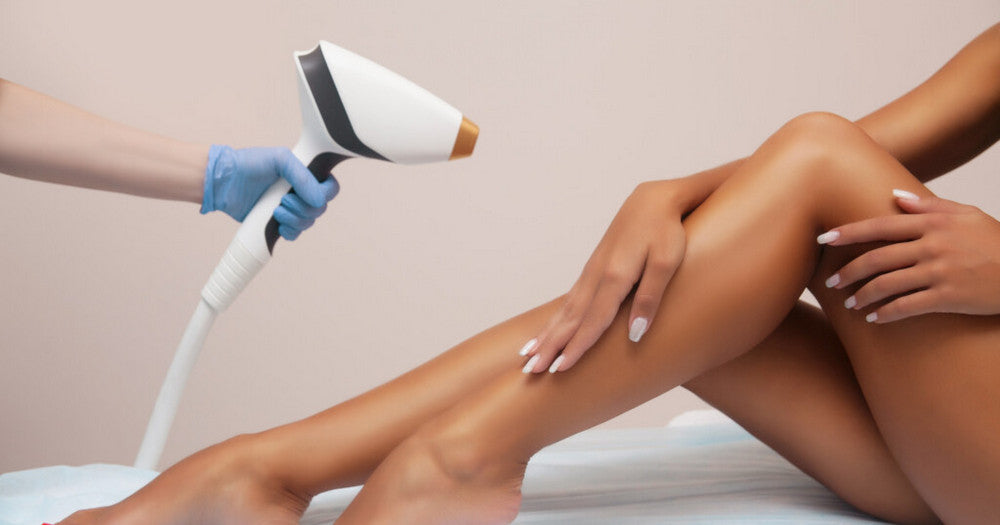IPL hair removal is a useful method for achieving long-lasting smooth skin. It provides results over months to years by eliminating hair follicles. Salons are available for IPL hair removal, but IPL devices for home use are also used nowadays.
The light from these devices hits your hair, creates heat and then destroys the hair follicles. If they are convenient and efficient, why are people hesitant to use them? Because there is a myth going around that these devices can cause cancer. Is this true? In this article, we will get to the truth behind it and also explain some other side effects you can expect from IPL devices.
Table of contents:- Part 1: Do IPL devices cause cancer?
- Part 2: How did the myth that IPL can cause cancer come about?
- Part 3: What are the possible side effects of IPL hair removal?
- Part 4: Are there long-term side effects of IPL devices?
- Part 5: Is IPL hair removal painful?
- Part 6: Tips for safe use of IPL devices
- Part 7: Conclusion
Do IPL devices cause cancer?
The IPL devices use polychromatic, non-coherent light beams aimed at your hair follicles. But this light does not cause cancer. If UV rays cause cancer, why not the light from IPL devices? Although radiation is one of the main causes of the widespread prevalence of cancer, not all types of radiation can cause cancer.

What does this mean? We'll make it easier for you. The different rays of the electromagnetic spectrum have different wavelengths and those that fall below 300 nm can cause cancer due to their high energy. This high energy has the potential to damage your DNA, leading to gene mutations and an increased risk of premature aging and cancer.
Fortunately, IPL devices use pulsed light beams that fall within the wavelength range of 500nm-1,200nm, making them safe for you. Additionally, several studies have been conducted on the subject, and no study has proven a link between IPL hair removal and cancer.
How did the myth that IPL can cause cancer come about?
We all know that the sun's rays can damage skin cells, leading to skin cancer, especially basal cell carcinoma, squamous cell carcinoma and melanoma.
In addition, those who were frequently exposed to X-rays also had cancer cells in their bodies. This led to the belief that any type of radiation can cause cancer. Since IPL devices also use light rays to damage hair follicles, people were convinced that they too could cause cancer in the body. But these IPL devices are safe to use and have only temporary side effects.
What are the possible side effects of IPL hair removal?
Although IPL devices are reliable for hair removal, you should expect some side effects. These side effects are more common in people with sensitive skin or those who use the device carelessly.

Redness
When you move an IPL device over the area to be treated, your skin comes into contact with the intense light and this light is converted into heat energy as soon as it reaches your hair follicles.
Continuous heat exposure to a single area can cause redness, but this is only temporary. In most cases, the redness lasts for a few hours and then goes away on its own. If it doesn't go away, you can put ice on your skin, but make sure the ice is covered with a cloth.
Skin burns
IPL hair removal can cause skin burns if you use the device on tattoos or tanned skin. The light from IPL devices targets the color-giving pigment in your skin and hair. Because the areas of dark skin contain more melanin, more heat can build up there, which can lead to first and, in some cases, second degree burns.
In addition, improper use can also lead to skin burns.
Blisters and scarring
Blisters and scarring after IPL hair removal are rare, but the likelihood is not completely zero. Mild blisters and sensitive skin after an IPL treatment are normal and will subside within a day. However, if you see severe blisters and scarring, it means your skin has suffered a thermal injury and you need to seek treatment.
These blisters can occur if you use the high intensity level on your sensitive areas or use the device on a single area for longer than recommended.
Hyperpigmentation
In most cases, IPL devices are used not only for hair removal but also for improving the appearance of the skin. It breaks down the melanin in your skin and makes your skin look brighter and fresher. But sometimes your body reacts against them due to the heat generated by IPL devices.
This leads to an inflammatory reaction, which results in hyperpigmentation. Post-inflammatory hyperpigmentation makes your skin look dark or brownish.
Are there any long-term side effects of IPL devices?
All the side effects of IPL that we have discussed so far are mostly rare and temporary. Now the question arises: Are there any long-term side effects of IPL?
An IPL device itself won't harm your skin, but if you use it improperly, there may be some side effects that last longer. For example, the rays emitted by IPL devices can damage your eyes if you don't wear protective goggles.
You won't feel anything the first time, but if you continue, you may experience photophobia, iris transillumination, and posterior synechiae, which can eventually affect your vision.
Is IPL hair removal painful?
Now that we fully understand the safety and risks of IPL, confusion still remains. Is it painful? Is the pain tolerable? Let's clear this up.
The light emitted by IPL hair removal devices is so gentle that it doesn't cause any pain. At most, you'll feel a rubber band snapping against your skin.
Some devices have a Cooling technology that doesn't even make you feel a minimum of pain. So IPL hair removal is minimally painful as long as you don't burn your skin while trying to remove your unwanted hair.

Tips for the safe use of IPL devices
So far we've talked about how IPL devices don't cause serious problems as long as you use them correctly. But what exactly is the right way? Let's take a look.
-
Shave before using the IPL device
When you start IPL hair removal, it is best to remove your hair but not at the roots. If you have long hair, the light from the IPL device will only destroy the visible hair without reaching the hair follicles.

You also need to cut the hair just above the skin surface so that the remaining short hairs act as a target for the light and help it reach the hair roots. The best way to cut your hair while leaving the roots intact is to shave, so don't forget to shave before IPL hair removal.
-
Wear protective goggles
Constant exposure to the light from an IPL device can damage your eyes. To make sure you are completely safe, you should wear protective goggles. These protective goggles will prevent harmful rays from entering your eyes.

Some devices, such as the Ulike Saphir Air 10, come with these safety glasses included. For most other brands, however, you have to buy them separately.
-
Use devices with ice cooling technology
There are IPL devices with built-in ice cooling systems that soothe your skin during the IPL treatment and prevent pain. These ice cooling systems also keep the temperature under control, thus protecting you from skin burns.

Do you want to get to know a device that is equipped with efficient ice cooling technology? The Ulike Saphir Air 10 has a 4-fold ice cooling system that lowers the temperature up to 10°C and protects you from unwanted burns, pain and redness.
-
Do a patch test
The intensity you need to use may vary from area to area. Sensitive areas like the underarms, upper lip and bikini line will burn at higher intensity, so you should keep the intensity low for these areas.
Therefore, before using the device, you should set the desired mode and intensity and try it on your arm or leg. If everything goes well, you can continue using the device with the same settings.
-
Buy FDA approved device
FDA approval increases the reliability of a device or procedure, so it's best if you buy an IPL device that's FDA approved or dermatologist recommended. The Ulike Sapphire Air 10 handheld device is not only FDA approved and dermatologist recommended, but it's also been certified by 30 other organizations for its safety and durability.
-
Avoid sun exposure before treatment
Excessive sun exposure triggers excess melanin production in your body, which causes hyperpigmentation and skin tanning. IPL devices are not suitable for dark or tanned skin, so avoid sun exposure if you plan to use an IPL device.
Avoid going outdoors, but if you must, wear sunscreen with an SPF of over 50 to protect yourself.
-
Make sure you have no contraindications to IPL application
IPL hair removal is contraindicated for pregnant women, people with sunburn or active infections. You should also not undergo IPL treatment if you suffer from seizures, eczema or other skin conditions. If you have a dark skin tone, you should also avoid IPL devices.
Using IPL devices in these cases can only cause harm, so before purchasing an IPL device, make sure you do not suffer from any of the above-mentioned conditions.
-
Pay attention to aftercare for IPL hair removal
IPL hair removal can make your skin sensitive, so avoid sun exposure and applying makeup products that contain harsh chemicals for at least 24 hours after your IPL treatment. They can cause allergic reactions and irritate your skin.
What to do then? Apply a moisturizer immediately after IPL hair removal to maintain your skin's protective barrier. This will keep your skin protected and supple.
Read also: Can I use IPL every day at home? (& dos and don'ts included)
Conclusion
The light in IPL devices has a wavelength of over 500 nm and therefore cannot be carcinogenic. But they can cause redness, itching, burns, hyperpigmentation and scarring in people with sensitive skin or if used incorrectly.
The correct way to use these devices is to shave first, then do a patch test and moisturize your skin after the treatment. But first make sure you have no contraindications to using an IPL device.



























